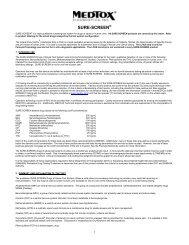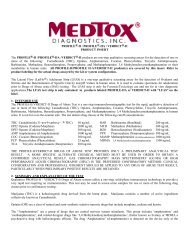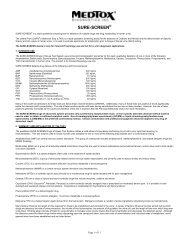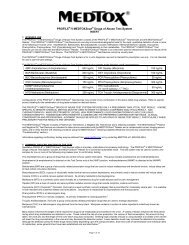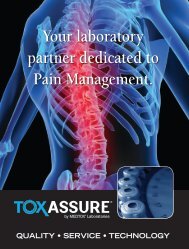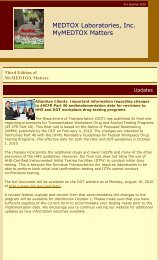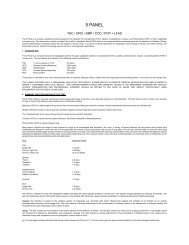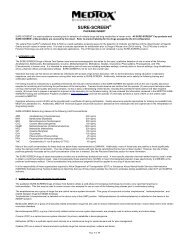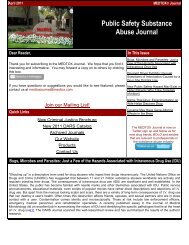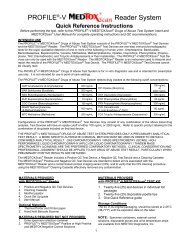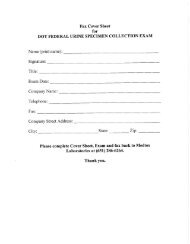Create successful ePaper yourself
Turn your PDF publications into a flip-book with our unique Google optimized e-Paper software.
5 <strong>PANEL</strong><br />
THC / OPI2 / AMP / COC / PCP + LFAS<br />
The 5 Panel is a one-step qualitative screening assay for the detection of Cannabinoids (THC), Opiates, Amphetamine, Cocaine, and Phencyclidine (PCP) or their metabolites<br />
in human urine. The device also contains a Lateral Flow (LatFlo ® ) Adulterant Strip (LFAS) which is a one-step qualitative screening assay for the detection of Oxidants, Nitrites,<br />
and the determination of Specific Gravity and pH Values in Human Urine. It is used to evaluate specimens for adulteration prior to Drugs of Abuse urine (DAU) testing. The<br />
LFAS strip is only for Forensic/Toxicology use and not for in vitro diagnostic applications.<br />
1. INTENDED USE<br />
The 5 Panel is a one-step immunochromatographic test for the rapid, qualitative detection of cannabinoids (THC), opiates, amphetamines, cocaine, and phencyclidine (PCP) in<br />
human urine. The test detects drug classes at the following cutoff concentrations:<br />
THC 11-nor-9-carboxy-∆ 9 -THC 50 ng/mL<br />
OPI2 Opiates (Codeine/Morphine) 2000 ng/mL<br />
AMP Amphetamine 1000 ng/mL<br />
COC Cocaine (Benzoylecgonine) 300 ng/mL<br />
PCP Phencyclidine 25 ng/mL<br />
This product is intended for use under medical supervision in hospitals, physician offices, health clinics and drug treatment/counseling centers. It is not for over-the-counter sale.<br />
THE 5 <strong>PANEL</strong> PROVIDES ONLY A PRELIMINARY ANALYTICAL TEST RESULT. A MORE SPECIFIC ALTERNATE CHEMICAL METHOD MUST BE USED IN ORDER TO<br />
OBTAIN A CONFIRMED ANALYTICAL RESULT. GAS CHROMATOGRAPHY/ MASS SPECTROMETRY (GC/MS) IS THE PREFERRED CONFIRMATORY METHOD.<br />
CLINICAL CONSIDERATION AND PROFESSIONAL JUDGMENT SHOULD BE APPLIED TO ANY DRUG OF ABUSE TEST RESULT, PARTICULARLY WHEN<br />
PRELIMINARY POSITIVE RESULTS ARE USED.<br />
2. SUMMARY AND EXPLANATION OF THE TEST<br />
The 5 Panel utilizes a one-step, solid-phase immunoassay technology to provide a very rapid test requiring no instrumentation. This test may be used to screen urine samples<br />
for one or more of the following drug classes prior to confirmatory testing:<br />
Marijuana (THC) is a hallucinogenic drug derived from the hemp plant. Marijuana contains a number of active ingredients collectively known as Cannabinoids.<br />
Opiates (OPI) are a class of natural and semi-synthetic sedative narcotic drugs that include morphine, codeine and heroin.<br />
The “Amphetamines” are a group of drugs that are central nervous system stimulants.<br />
Cocaine (COC) is a central nervous system stimulant. Its primary metabolite is benzoylecgonine.<br />
Phencyclidine (PCP) is a hallucinogenic drug.<br />
Many factors influence the length of time required for drugs to be metabolized and excreted in the urine. A variety of factors influence the time period during which drug<br />
metabolites are detected in urine; the rate of urine production, the volume of fluid consumption, the amount of drug taken, the urine pH, and the length of time over which drug<br />
was consumed. Drinking large volumes of liquid or using diuretics to increase urine volume will lower the drug concentration in the urine and may decrease the detection period.<br />
Although the detection period for these drugs varies widely depending upon the compound taken, dose and route of administration and individual rates of metabolism, some<br />
general times have been established and are listed below. 1-4<br />
Drug Detection Period<br />
THC<br />
Single Use 1-3 days<br />
Chronic, Light Use 3-29 days<br />
Chronic, Heavy Use Up to 12 weeks<br />
Opiates<br />
Heroin 2-5 days<br />
Morphine 1-3 days<br />
Codeine 1-3 days<br />
Amphetamines<br />
Acid Conditions 1-3 days<br />
Alkaline Conditions 3-10 days<br />
Cocaine 1-3 days<br />
PCP<br />
Single Use 7-8 days<br />
Chronic Use 2-4 weeks<br />
The LFAS is a lateral flow strip with impregnated reagent test pads that detect specific analytes in human urine. The specific analytes detected are Oxidants and Nitrites. The<br />
strip also determines the pH and specific gravity values. Urine samples with ‘abnormal’ values should be submitted to a reference laboratory for additional testing.<br />
Oxidants The detection is based on the oxidative activity of compounds (e.g. chromate salts and/or Bleach) that catalyze the oxidation of an indicator by an organic<br />
hydroperoxide producing a blue/orange color. The color intensity is directly proportional to the concentration of Oxidants present in the sample and is observed visually and<br />
compared to the color comparator chart to obtain a result.<br />
Nitrites The test is based on the principles of the Griess reaction for the detection of Nitrites. The test pad contains an amine and a coupling component. A red/orange colored<br />
azo compound is obtained by diazotization and subsequent coupling. The color intensity is directly proportional to the concentration of Nitrites present in the sample and is<br />
observed visually and compared to the color comparator chart to obtain a result.<br />
pH The test paper contains indicators that change colors between pH 2 and pH 11. The color scale gives an approximate indication for pH values between those levels.
Specific Gravity The test paper reacts with ions in urine to indicate concentrations from 1.000 to 1.020. The color changes range from dark green with low ionic concentrations<br />
through green to yellow/orange in urines with high ionic concentrations. The color is observed visually and compared to the color comparator chart to obtain an approximate<br />
result.<br />
3. PRINCIPLES OF THE PROCEDURE<br />
The 5 Panel test is a one-step, competitive, membrane-based immunochromatographic assay. A single urine sample can be evaluated for the presence of each of the five<br />
specified classes of drugs on a single device. Cannabinoids (THC), opiates, amphetamines, cocaine and phencyclidine are assayed on the strip. Each test strip consists of<br />
three main components, antibody-colloidal gold on the sample pad, drug conjugates on the membrane, and a control line on the membrane:<br />
1) ANTIBODY-COLLOIDAL GOLD Mouse monoclonal drug antibodies were developed. Each antibody only binds drug(s) from the drug class tested. Antibody-colloidal gold<br />
solutions were prepared by absorbing each of the individual monoclonal antibodies to colloidal gold. The colloidal gold solutions were applied to the sample well pad in the<br />
drugs of abuse test.<br />
2) DRUG CONJUGATES Drug from the class tested was individually conjugated to bovine serum albumin (BSA) or IgG. Each drug conjugate was immobilized as a line at a<br />
labeled location on the membrane strip.<br />
3) CONTROL LINE Each test strip has anti-mouse immunoglobulin antibody immobilized as a line on the membrane at the CTRL location on the device window. The antimouse<br />
immunoglobulin antibody can bind to any of the mouse antibodies coated on the colloidal gold.<br />
The 5 Panel device can be used to detect specific classes of drugs in urine because drugs in the urine and the drugs conjugated to the BSA compete to bind to the antibodycolloidal<br />
gold in a highly specific reaction. When the urine sample is placed in the sample well, the dried antibody-colloidal gold on the sample pad dissolves and the urine wicks<br />
down the white strip carrying the reddish-purple antibody-colloidal gold as a solution with it.<br />
Negative Samples<br />
When no drug is present in the urine sample, each of the five reddish-purple antibody-colloidal gold solutions migrate along the strip and then bind to the appropriate drug<br />
conjugate immobilized on the membrane. The binding of the antibody-colloidal gold to the drug conjugate generates an easily visible reddish-purple line at each of the labeled<br />
locations in the result window. Negative results can be reported as soon as the drug and control lines are visible.<br />
Positive Samples<br />
When one or more of the five drugs are present in the urine sample, the antibody-colloidal gold will bind the drug before the gold migrates along the strip. However, when the<br />
antibody-colloidal gold binds the drugs in the urine, the antibody-colloidal gold cannot bind to the drug conjugate immobilized on the membrane. When the drug concentration is<br />
at or above the cutoff concentration, the majority of the antibody-colloidal gold is bound to drug from the urine. As the drug bound antibody-colloidal gold migrates along the<br />
strip, it is unable to bind to the appropriate drug conjugate immobilized on the membrane. As a result no line is generated at the drug-specific location in the result window. Read<br />
positive results at 5 minutes. The control line should be present for the test to be valid. The test must be read within 15 minutes of the sample application. The test result after 15<br />
minutes may not be consistent with the original reading.<br />
CTRL Line<br />
The test strip has an internal procedural control. A line must form at the Control (CTRL) position in the result window to indicate that the proper sample volume was used and<br />
that the reagents are migrating properly. If a Control line does not form, the test is considered invalid. A Control line forms when the antibody-colloidal gold binds to the antimouse<br />
immunoglobulin antibody immobilized on the membrane at the CTRL location(s) near the top of the device window.<br />
4. MATERIAL PROVIDED/STORAGE CONDITIONS<br />
Each 5 Panel test contains all the reagents necessary to test one urine sample simultaneously for all five drugs and four adulterant tests.<br />
1. One 5 Panel test strip. The test strip contains a membrane strip coated with drug conjugates and a pad coated with the five antibody-dye complexes (mouse monoclonals to<br />
THC, morphine, amphetamine, benzoylecgonine and phencyclidine) in a protein matrix.<br />
2. One LFAS test strip. The test strip contains a membrane strip laminated with Adulterant test pads for testing the presence of Oxidants, and Nitrites, as well as determining<br />
approximate values of Specific Gravity and pH in human urine.<br />
3. One disposable 100 µl sample pipette.<br />
Kit Contents -The 5 Panel test kit contains the following:<br />
1. Twenty-five (25) test devices in individual foil packages containing a sample pipette.<br />
2. One instructional package insert.<br />
3. Five Color Comparator Charts.<br />
Storage Conditions<br />
The kit, in its original packaging, should be stored at 2-25°C (36-77°F) until the expiration date on the label.<br />
5. PRECAUTIONS<br />
1. Urine specimens and all materials coming in contact with them should be handled and disposed of as if infectious and capable of transmitting infection. Never pipette by<br />
mouth and avoid contact with broken skin.<br />
2. Avoid cross-contamination of urine samples by using a new urine specimen container and pipette for each urine sample.<br />
3. The 5 Panel device should remain in its original sealed foil pouch until ready to use. If the pouch is damaged, do not use the test.<br />
4. Do not store the test kit at temperatures above 25°C (77°F).<br />
5. If devices have been stored refrigerated, bring to ambient temperature (18 to 25°C/64 to 77°F) prior to opening foil pouch.<br />
6. Do not use tests after the expiration date printed on the package label.<br />
7. The 5 Panel test is for in vitro diagnostic use while the LFAS test is only for Forensic/Toxicology use and not for in vitro diagnostic applications.<br />
8. For the 5 Panel strip, if any of the lines formed are outside the arrow indicated by the drug name, the test is invalid.<br />
6. SAMPLE COLLECTION AND PREPARATION<br />
The urine sample should be collected in a clean glass or plastic container. Approximately 100 µL is required for each sample well. Collection of 45 mL of urine is more than<br />
sufficient for initial and subsequent testing. No preservatives should be added. Urine may be tested immediately following collection. If it is necessary to store the urine, store<br />
under refrigeration for no more than one day. Urine may be frozen for longer storage. Stored urine must be brought to ambient temperature (18 to 25°C/64 to 77°F) and mixed<br />
well to assure a homogeneous sample prior to testing.
7. MATERIAL REQUIRED BUT NOT PROVIDED<br />
1. Urine collection container.<br />
NOTE: Specimen containers, disposable gloves and urine temperature strips are available from MEDTOX Diagnostics, Inc.<br />
8. TEST PROCEDURE<br />
1. Open one pouch for each sample to be tested and label the device with the patient or sample identification (ID). (You may notice a reddish-purple color in the sample well.<br />
This is normal, do not discard the test).<br />
2. Obtain the Color Comparator chart.<br />
3. Apply 100 µl of urine to sample well as follows:<br />
• Hold the 100 µl sample pipette by the upper bulb.<br />
• Lower the pipette stem into the urine sample.<br />
• Squeeze the upper bulb then release it. This motion will draw 100 µl of urine into the stem. The urine sample should reach the top of the stem, and a drop or two<br />
should overflow into the middle bulb, if not, repeat this process.<br />
• Dispense the urine into the sample well by squeezing the upper bulb. This will empty the stem delivering 100 µL of sample. Excess urine in the middle bulb should<br />
remain in the bulb.<br />
4. For the LFAS strip, allow the urine specimen to migrate down the test strip. Read the results for Nitrite, Specific Gravity and pH immediately after the pads are wetted with<br />
the sample. Read the results for the Oxidant test pad one minute after the pads are wetted with the sample.<br />
5. For the 5 Panel strip, read the results at 5 minutes after sample application.<br />
9. READING THE TEST RESULTS<br />
Negative: The appearance of both a reddish-purple Control (CTRL) line and a specific drug line indicates a negative test result. The color intensities of the Control line<br />
and a specific drug line may not be equal; any reddish-purple line visible at 5 minutes indicates a negative test result. Line intensity will vary from<br />
test to test.<br />
Non-Negative: The appearance of both a reddish-purple Control (CTRL) line and the absence of a line next to a specific drug name at 5 minutes indicate a preliminary<br />
positive test result for that drug. Occasionally a white line (line lighter than the background of the strip) may appear next to a specific drug name and<br />
indicates a preliminary positive test result for that drug.<br />
Invalid: The absence of a reddish-purple Control (CTRL) line indicates the test is invalid. The urine sample should be retested on a new device.<br />
10. INTERPRETATION OF TEST RESULTS<br />
A NEGATIVE test result for a specific drug indicates that the sample does not contain the drug/drug metabolite above the cutoff level.<br />
A POSITIVE or NON-NEGATIVE test result for a specific drug indicates that the sample contains drug/drug metabolite at or above the cutoff level. It does not indicate the level<br />
of intoxication or the specific concentration of drug in the urine sample.<br />
Examples of Negative and Non-Negative results are shown below.<br />
There are other possible results depending on the drug or combination of drugs present in the urine sample.<br />
11. QUALITY CONTROL<br />
An internal procedural control is included on each device. A line must form at the Control (CTRL) position in the result window to indicate that the proper sample volume was<br />
used and that the reagents are migrating properly. If a Control line does not form, the test is considered invalid. The Control line consists of immobilized anti-mouse antibody<br />
that reacts with the antibody-colloidal gold as it passes this region of the membrane. Formation of a visible line verifies the Control line antibody antigen reaction occurred. This<br />
line may be considered an internal negative procedural control. In addition, if the test has been performed correctly and the device is working properly, the background will clear<br />
such that result lines are distinct. The cleared background may be considered an internal positive procedural control. The visible Control line should always be present<br />
regardless of whether drug is absent or present in the sample.<br />
The purpose of quality control in laboratory testing is to ensure accuracy, reliability of results and to detect errors. Because the devices are self-contained, single use tests,<br />
traditional quality control programs do not apply. The Quality Control program MEDTOX recommends for these non-instrumented test devices includes a combination of the<br />
internal device controls and external controls to ensure accuracy, reliability and to detect possible errors. The on-board reactive device controls may be one aspect of the quality<br />
program utilized by a laboratory to satisfy the daily quality control requirement established by the Laboratory Director. Another aspect of a quality control program includes an<br />
external negative control containing no drug and a positive drug control challenging to the assay cutoff concentration. These controls may be used to initially test each shipment<br />
of product received by the laboratory or to verify appropriate storage conditions and long-term stability of the test reagent. To follow good laboratory practices, we recommend<br />
that the user document the receipt of each new lot number of devices, the results of external controls performed initially and periodically thereafter, and the results of the internal<br />
controls within each device.<br />
It is the responsibility of each Laboratory Director to demonstrate and document the validity of the alternate QC procedure they choose to use in their laboratory. For additional<br />
information or forensic and workplace testing requirements, users should contact and follow the appropriate federal, state, and local guidelines. Quality control materials are<br />
available from commercial sources. Contact MEDTOX for further information.<br />
12. LIMITATIONS OF THE PROCEDURE<br />
1. The 5 Panel test is only for use with unadulterated human urine samples.<br />
2. A positive result for any drug(s) in the test does not indicate or measure intoxication. It only indicates the presence of specific drug(s) in the urine specimen.<br />
3. Test results interpreted after 15 minutes may not be consistent with the original result obtained at 5 minutes.<br />
4. The 5 Panel Drugs of Abuse Test was not evaluated in point-of-care settings.<br />
5. There is a possibility that other substances and/or factors not listed above, e.g. technical or procedural errors may interfere with the test and cause false results.<br />
LFAS Strip<br />
The purpose of the adulteration strip is to screen for abnormal conditions in human urine samples, such as dilution or the addition of drug-test interfering substances.<br />
Occasionally medications may discolor the urine, and make it difficult to read the result. When in doubt send the urine sample to a reference laboratory for additional testing.<br />
Oxidant<br />
Nitrites, acting as oxidizing agents in solution, will produce a blue/green color change on the Oxidant pad.<br />
Nitrite
Abnormal results can be caused by the presence of diagnostic or therapeutic dyes in the urine. Very high concentrations of oxidant such as 80% bleach will produce a brown<br />
color change on the Nitrite pad.<br />
13. EXPECTED VALUES<br />
The Substance Abuse and Mental Health Services Administration (SAMHSA) recommends the following<br />
screening test cutoffs:<br />
THC 11-nor-9-carboxy-∆ 9 -THC 50 ng/mL<br />
OPI Morphine and Codeine 2000 ng/mL<br />
AMP Amphetamine 1000 ng/mL<br />
COC Benzoylecgonine 300 ng/mL<br />
PCP Phencyclidine 25 ng/mL<br />
The 5 Panel Drugs of Abuse Test qualitatively detects THC, opiates, amphetamines, cocaine and phencyclidine and/or their metabolites as listed (See Specificity).<br />
LFAS Test:<br />
Urines that produce an abnormal result on the LFAS adulteration strip should be sent to a reference laboratory for more definitive testing to determine if the urine may be dilute,<br />
substituted, invalid and/or adulterated.<br />
14. PERFORMANCE CHARACTERISTICS<br />
Sensitivity<br />
The 5 Panel test detects cannabinoids (THC), opiates, amphetamines, cocaine metabolite, and phencyclidine based on SAMHSA recommendations for screening of these<br />
drugs in human urine 3 .<br />
THC 11-nor-∆ 9 -THC-9-COOH 50 ng/mL<br />
OPI Morphine 2000 ng/mL<br />
AMP Amphetamine 1000 ng/mL<br />
COC Benzoylecgonine 300 ng/mL<br />
PCP Phencyclidine 25 ng/mL<br />
Accuracy<br />
For THC, OPI, AMP, COC and PCP a panel of naturally metabolized urine samples were analyzed using the 5 Panel test and the Boehringer Mannheim qualitative CEDIA ®<br />
assay or the Roche Abuscreen OnLine ® II for each drug and the results obtained in the two procedures were compared. Results are shown in the following tables.<br />
ACCURACY COMPARED TO THE BOEHRINGER MANNHEIM<br />
QUALITATIVE CEDIA ® OR THE ROCHE ABUSCREEN ONLINE ® II ASSAYS<br />
CEDIA MULTI-LEVEL THC (50 ng/mL cutoff)<br />
Positive Negative TOTAL<br />
Positive 194 3 197<br />
THC Negative 10 477 487<br />
TOTAL 204 480 684<br />
Overall agreement: 98% (671/684). Samples having discrepant results were analyzed by GC/MS. The three false positive samples were found to contain 16, 28, and 34 ng/mL<br />
while the ten false negative samples contained 32, 35, 41, 42, 46, 46, 49, 50, 50, and 90 ng/mL.<br />
ROCHE ABUSCREEN ONLINE-II ASSAY<br />
OPIATE (2000 ng/mL cutoff)<br />
Positive Negative TOTAL<br />
Positive 68 0 68<br />
OPIATES Negative 0 89 89<br />
TOTAL 68 89 157<br />
Overall agreement: 100% (157/157).<br />
CEDIA AMPHETAMINE (1000 ng/mL cutoff)<br />
Positive Negative TOTAL<br />
Positive 64 0 64<br />
AMPHETAMINE Negative 2 618 620<br />
TOTAL 66 618 684<br />
Overall agreement: >99% (682/684). Samples having discrepant results were analyzed by GC/MS. The two false negative samples contained amphetamine at 2353 and 3569<br />
ng/mL.<br />
CEDIA COCAINE (300 ng/mL cutoff)<br />
Positive Negative TOTAL<br />
Positive 96 8 104<br />
COCAINE Negative 2 578 580<br />
TOTAL 98 586 684<br />
Overall agreement: 99% (674/684). Samples having discrepant results were analyzed by GC/MS. Of the eight false positive samples one contained 154 ng/mL while seven did<br />
not contain cocaine metabolite detectable at the GC/MS cutoff of 150 ng/mL. The two false negative samples contained cocaine metabolite at 688 and 666 ng/mL.<br />
CEDIA PHENCYCLIDINE (25 ng/mL cutoff)<br />
Positive Negative TOTAL<br />
Positive 56 2 58<br />
PCP Negative 1 625 626<br />
TOTAL 57 627 684
Overall agreement: >99% (681/684). Samples having discrepant results were analyzed by GC/MS. The two false positive samples did not contain phencyclidine detectable at<br />
the GC/MS cutoff of 25 ng/mL. The one false negative sample contained phencyclidine at 28 ng/mL.<br />
RELATIVE SENSITIVITY AND SPECIFICITY COMPARED TO THE BOEHRINGER MANNHEIM QUALITATIVE CEDIA ® OR ROCHE ABUSCREEN ONLINE ® ASSAYS<br />
Relative Sensitivity Relative Specificity<br />
THC 95% (194/204) 99% (477/480)<br />
OPI 100% (68/68) 100% (89/89)<br />
AMP 97% (64/66) 100% (618/618)<br />
COC 98% (96/98) 99% (578/586)<br />
PCP 98% (56/57) >99% (625/627)<br />
ACCURACY COMPARED TO GC/MS<br />
Values for Discrepant<br />
5 Panel GC/MS<br />
Samples (ng/mL)<br />
THC Positive 48 50<br />
Negative 52 50 35 and 46<br />
OPI Positive 47 47<br />
Negative 0 0 No Discrepants<br />
AMP Positive 48 50<br />
Negative 52 50 2353 and 3569<br />
COC Positive 49 50<br />
Negative 51 50 666<br />
PCP Positive 49 50<br />
Negative 51 50 28<br />
Precision<br />
Performance of the 5 Panel test around the specific cutoff for each drug was evaluated by testing standard drug solutions diluted in drug-free urine in replicates of 20 each on 3<br />
different days by 3 operators. Twenty replicates of drug-free urine were also tested on each day. At 25% above the cutoff, the precision of each assay was as follows:<br />
THC=95%, OPI=96.7%, AMP=100%, COC=100%, and PCP = 98%.<br />
Reproducibility<br />
A panel of 55 naturally metabolized human urine samples comprised of drug-free and contaminated samples was prepared. All samples in the panel had been screened for the<br />
presence or absence of THC, OPI, AMP, COC, and PCP. In addition each of the 55 samples had also been quantitated by GC/MS conducted at SAMHSA cutoffs for positive<br />
samples or at limit of quantitation for negative samples to determine the concentration of a specific drug. The concentration of primary metabolite in the positive samples was<br />
between 66 and 198ng/mL for THC, 487 and 1342ng/mL for COC, 2000 and 6000ng/mL for OPI,1056 and 4622ng/mL for AMP and 32 and 109ng/mL for PCP. The panel was<br />
used to evaluate the lot-to-lot and lab-to-lab reproducibility of the 5 Panel test.<br />
Lot-to-Lot Reproducibility<br />
Lot-to-Lot Reproducibility<br />
Three aliquots of each of the 55 samples were prepared and each of the three sets of aliquots were coded and used to evaluate the performance of one lot of 5 Panel. There<br />
was one incorrect result (a false negative on an amphetamine low positive sample) on the 825 tests for a reproducibility of >99%.<br />
Lab-to-Lab Reproducibility<br />
Three aliquots of each of the 55 samples were prepared and each of the three sets of aliquots were tested by one study participant using one lot of 5 Panel. There were three<br />
incorrect results (one false negative each on an opiate and a PCP low positive sample and one false negative on an opiate high positive sample) on the 825 tests for a<br />
reproducibility of >99%.<br />
Non Crossreactive Endogenous Compounds<br />
Fifteen compounds were dissolved in appropriate solvents at a concentration of at least 1.0 mg/mL. Each compound was further diluted to 100 µg/mL except for albumin (20<br />
mg/mL) and bilirubin (200 µg/mL). None of these compounds showed cross-reactivity at the listed concentrations.<br />
Acetaldehyde Creatinine Hemoglobin, Human<br />
Acetone Epinephrine Sodium Chloride<br />
Albumin, Human β-Estradiol Tetrahydrocortisone<br />
Bilirubin Estriol d,1-Thyroxine<br />
Cholesterol Glucose Std. Solution Uric Acid<br />
Specificity<br />
Unrelated Compounds, Prescription and Over-the-Counter Medications<br />
The following compounds were tested for reactivity. Listed compounds were dissolved in appropriate solvents and then added to drug-free urine for testing. Unless otherwise<br />
noted, all of the listed compounds were negative in each of the five tests at 100 µg/mL. If a drug name is followed by an abbreviation such as “AMP” or “OPI” etc., check the<br />
“Related Compounds and Cross Reactants” listing for the drug in question under the appropriate heading (AMP, OPI, etc.) The drug may not cause a presumptive positive drug<br />
screen for that drug class.<br />
Acecainide (N-<br />
Acetylprocainamide)<br />
Acetaminophen Acetylsalicyclic Acid Allobarbital Alphenal<br />
Alprazolam- Alprazolam, 1-Hydroxy p-Aminobenzoic Acid 7-Aminoclonazepam 7-Aminoflunitrazepam<br />
Aminoglutethimide<br />
l-Aminopyrine (4-<br />
(dimethylamino) antipyrine)<br />
Amitriptyline Amobarbital Amoxapine<br />
Amoxicillin d-Amphetamine-AMP, l- Amphetamine-AMP Ampicillin Apomorphine-OPI<br />
l-Ascorbic Acid Aspartame Atenolol Atomoxetine Atropine Sulfate<br />
Barbital Barbituric Acid Benzilic Acid Benzoic Acid Benzocaine (ethyl-4-aminobenzoate)<br />
Benzoylecgonine-COC Benzphetamine Benztropine Brompheniramine Buprenorphine (Methadone replacement)<br />
Bupropion Butabarbital Butalbital Caffeine Cannabidiol-THC<br />
Cannabinol-THC Captopril Carisoprodol (Meprobamate) Cephalexin Chloral Hydrate<br />
Chloramphenicol Chlordiazepoxide Chloroquine Chlorothiazide Chlorpheniramine<br />
Chlorpromazine Chlorprothixene Clobazam Clomipramine Clonazepam<br />
Clonidine Clorazepate Clozapine Cocaine-COC Codeine-OPI<br />
Cortisone Cotinine Cyclobenzaprine Cyclopentobarbital Deoxycorticosterone<br />
Desalkylflurazepam Desipramine<br />
Desmethylchlordiazepoxide<br />
(Norchlordiazepoxide)<br />
Desmethylflunitrazepam Desmethylvenlafaxine<br />
Dexamethasone Dextromethorphan Diacetylmorphine-OPI Diazepam Diclofenac<br />
Diethylpropion Diflunisal Digoxin Dihydrocodeine-OPI Dimenhydrinate (Dramamine)
1,3-Dimethylbarbituric acid Diphenhydramine Diphenylhydantoin (Phenytoin) Domperidone Dopamine<br />
Doxepin Doxylamine Ecgonine-COC Ecgonine Methyl Ester-COC EDDP-<br />
(Primary metabolite of<br />
methadone)<br />
Efavirenz (Sustiva) EMDP-<br />
(Secondary metabolite of<br />
methadone)<br />
Ephedrine-AMP<br />
Equilin Erythromycin Estrone Ethanol Ethylmorphine-OPI<br />
Fenfluramine Fenoprofen Fentanyl (Synthetic opiate) Flunitrazepam Fluoxetine (Prozac)<br />
Flurazepam Furosemide Fuvoxamine<br />
Gentisic Acid (2,5-<br />
Dihydroxybenzoic acid)<br />
Glutethimide<br />
Guaiacol Glyceryl Ether Haloperidol Hexobarbital Hippuric acid Hydralazine<br />
Hydrochlorothiazide Hydrocodone-OPI Hydrocortisone Hydromorphone-OPI Hydroxybupropion<br />
l-11-Hydroxy-∆9-THC-THC p-Hydroxyphenobarbital 4-Hydroxyphencyclidine-PCP 3-Hydroxytyramine Hydroxyzine<br />
Ibuprofen Imipramine Iproniazid (R)-Isoproterenol Isoxsuprine-COC<br />
Ketamine Ketoprofen Labetalol Levorphanol-OPI Lidocaine<br />
Lithium carbonate Loperamide Lorazepam Lorazepam glucuronide Loxapine<br />
Lysergic Acid<br />
Lysergic Acid Diethylamide<br />
(LSD)<br />
Maprotiline MDA-AMP MDE (MDEA)-AMP<br />
MDMA-AMP Melanin Meperidine Mephobarbital Mepivacaine<br />
Mesoridazine Methadone d-Methamphetamine-AMP l-Methamphetamine- AMP Methaqualone<br />
Methcathinone Methocarbamol Methoxyphenamine Methylphenidate Methylprylon<br />
Metoprolol Midazolam Mirtazapine 6-Monoacetylmorphine-OPI Morphine-OPI<br />
Morphine 3- β -D-<br />
Glucuronide-OPI<br />
Morphine 6- β -D-<br />
Glucuronide-OPI<br />
Nalidixic Acid Naltrexone-OPI Nalorphine-OPI<br />
Naloxone-OPI Naproxen Niacinamide Nicotine Nifedipine<br />
Nitrazepam Nitrofurantoin Norclomipramine Norcodeine-OPI Nordiazepam<br />
Nordoxepin Norethindrone Norlysergic Acid Normeperidine Norpropoxyphene<br />
l-Norpseudoephedrine Nortriptyline Noscapine Nylidrin Octopamine<br />
Ofloxacin Omeprazole Orphenadrine Oxalic Acid Oxaprosin<br />
Oxazepam Oxazepam glucuronide Oxolinic Acid Oxycodone-OPI Oxymetazoline<br />
Oxymorphone-OPI Papaverine hydrochloride Penicillin G Pentazocine Pentobarbital<br />
Perphenazine<br />
Phenacetin<br />
(Acetophenetidin)<br />
Phencyclidine-PCP Phendimetrazine Phenelzine<br />
Phenethylamine-AMP Pheniramine Phenmetrazine Phenobarbital Phenothiazine<br />
Phentermine-AMP<br />
Phenytoin<br />
(Diphenylhydantoin)<br />
Phenylbutazone Phenylephrine Phenylpropanolamine<br />
Piroxicam Prazosin Prednisolone Prednisone Procaine-OPI<br />
Procainamide Prochlorperazine Promazine Promethazine Propoxyphene<br />
Propranolol Protriptyline Pseudoephedrine Pyrilamine Quetiapine (Seroquel)<br />
Ranitidine Riboflavin Rifampin Salicylic Acid Secobarbital<br />
Selegiline (Deprenyl)<br />
Serotonin (5-<br />
Hydroxytryptamine)<br />
Sertraline (Zoloft) Sidenafil (Viagra) Sulfamethazine<br />
Sulindac Talbutal Temazepam Temazepam glucuronide Tetracycline<br />
∆9-Tetrahydrocannabinol- THC<br />
∆8-Tetrahydrocannabinol- THC<br />
Tetrahydrozoline Thebaine-OPI Theopyline<br />
Thiamine Thiopental Thioridazine Thiothixene Tolbutamide<br />
Tolmetin (Tolectin) Trazodone Triamterene Triazolam Triazolam, 1-hydroxy<br />
Trifluoperazine Trimethoprim Trimipramine Tripelennamine Tryptamine<br />
Tryptophan Tyramine-AMP Tyrosine Valproic Acid Venlafaxine<br />
Verapamil Zomepirac<br />
Related Compounds and Cross Reactants<br />
The following metabolites and related compounds were tested in the 5 Panel test. Reference standards for the various metabolites and related compounds were prepared in<br />
negative urine samples. None of the materials related to one drug reacted with the remaining four tests in the panel. Results are expressed as the minimum concentration<br />
required to produce a positive result in the indicated assay.<br />
Cannabinoids-(THC) (11-nor-9-carboxy-∆9-THC) 50 ng/mL<br />
Cannabidiol<br />
Result<br />
Negative at 100 µg/mL<br />
Cannabinol Negative at 100 µg/mL<br />
l-11 Hydroxy-∆9-THC Negative at 50 µg/mL<br />
∆8 –Tetrahydrocannabinol Negative at 100 µg/mL<br />
∆9 –Tetrahydrocannabinol Negative at 100 µg/mL<br />
Opiates(2000)-(OPI) (Codeine and Morphine) 2000ng/mL<br />
Apomorphine<br />
Result<br />
Negative at 100µg/mL<br />
Diacetylmorphine Positive at 2.0 µg/mL<br />
Dihydrocodeine Positive at 3 µg/mL<br />
Ethylmorphine Positive at 400 ng/mL<br />
Hydrocodone Positive at 2.0 µg/mL<br />
Hydromorphone Positive at 3 µg/mL<br />
Levorphanol Positive at 12.5 µg/mL<br />
6-Monoacetyl Morphine Positive at 3 µg/mL<br />
Morphine 3-β-D-Glucuronide Positive at 3 µg/mL<br />
Morphine 6-β-D-Glucuronide Positive at 25 µg/mL<br />
Nalorphine Negative at 100 µg/mL<br />
Naloxone Negative at 100 µg/mL<br />
Naltrexone Negative at 100 ug/mL<br />
Norcodeine Positive at 25 µg/mL<br />
Oxycodone Negative at 100 µg/mL<br />
Oxymorphone Negative at 100 µg/mL<br />
Procaine Negative at 100 µg/mL<br />
Thebaine Positive at 50 µg/mL<br />
Amphetamines- (AMP)(d-Amphetamine) 1000 ng/mL<br />
l-Amphetamine<br />
Result<br />
Positive at 100 µg/mL<br />
Ephedrine Negative at 100 µg/mL<br />
MDA Positive at 400 ng/mL<br />
MDMA Negative at 100 µg/mL
MDE (MDEA) Negative at 100 µg/mL<br />
l-Methamphetamine Negative at 100 µg/mL<br />
d-Methamphetamine Negative at 100 µg/mL<br />
Phenethylamine Negative at 100 µg/mL<br />
Phentermine Positive at 10 µg/mL<br />
Tyramine Negative at 100 µg/mL<br />
Cocaine-(COC) (Benzoylecgonine) 300 ng/mL<br />
Cocaine<br />
Result<br />
Positive at 800 ng/mL<br />
Ecgonine Negative at 100 µg/mL<br />
Ecgonine Methyl Ester Negative at 100 µg/mL<br />
Isoxsuprine Positive at 6 µg/mL<br />
Phencyclidine-(PCP) (Phencyclidine) 25 ng/mL<br />
Result<br />
4-Hydroxyphencyclidine Positive at 5 µg/mL<br />
15. BIBLIOGRAPHY<br />
1. Blum, K. Handbook of Abusable Drugs. Gardener Press, Inc. New York, New York, 1984. pp. 305-349.<br />
2. DeCresce, R.P., Lifshitz, M.S., Mazura, A.C. and Tilson, J.E. Drug Testing in the Workplace. ASCP Press. American Society of Clinical Pathologists. Chicago, Illinois.<br />
1989. pp. 105-109.<br />
3. Federal Register: Volume 59:2998. June 9, 1994.<br />
4. Baselt, R.C. and Cravey, R.H. Disposition of Toxic Drugs and Chemicals in Man. Chemical Toxicology Institute. Foster City, California.1995. pp. 22-761.<br />
16. LIMITED EXPRESS WARRANTIES<br />
The manufacturer makes no express warranty other than the diagnostic test kit will measure certain drugs and/or drug metabolites and adulterants when used in accordance<br />
with the manufacturer's printed instructions. The use of the kit for any other purpose is outside the intended use of this product. The manufacturer gives no express warranty as<br />
to what the legal or clinical significance is of the levels of drug(s)/drug metabolites detected by the 5 Panel THC/OPI2/AMP/COC/PCP + LFAS. The manufacturer disclaims any<br />
and all implied warranties of merchantability, fitness for use or implied utility for any other purposes. Any and all damages for failure of the kit to perform to its instructions are<br />
limited to the replacement value of the kit.<br />
Covered by one or more patents.<br />
U.S. Patent Nos. 5,202,268, 6,566,051, 6,376,251<br />
P/N 101439<br />
Rev. 8/07<br />
Printed in USA<br />
This product does not contain controlled substances.<br />
This product does not contain hazardous or toxic chemicals as defined by the OSHA Hazard Communication Rule [29 CFR 1910.1200(g)].<br />
To place an order or for technical service, call 1-800-832-3244.<br />
MEDTOX Diagnostics, Inc.<br />
1238 Anthony Road<br />
Burlington, NC 27215



